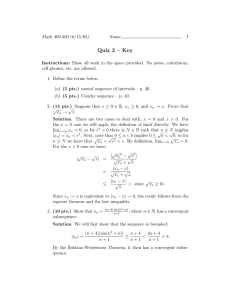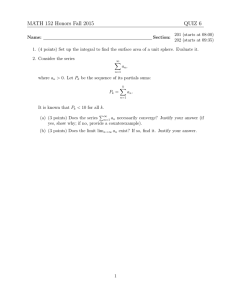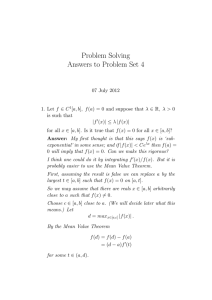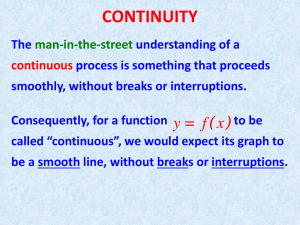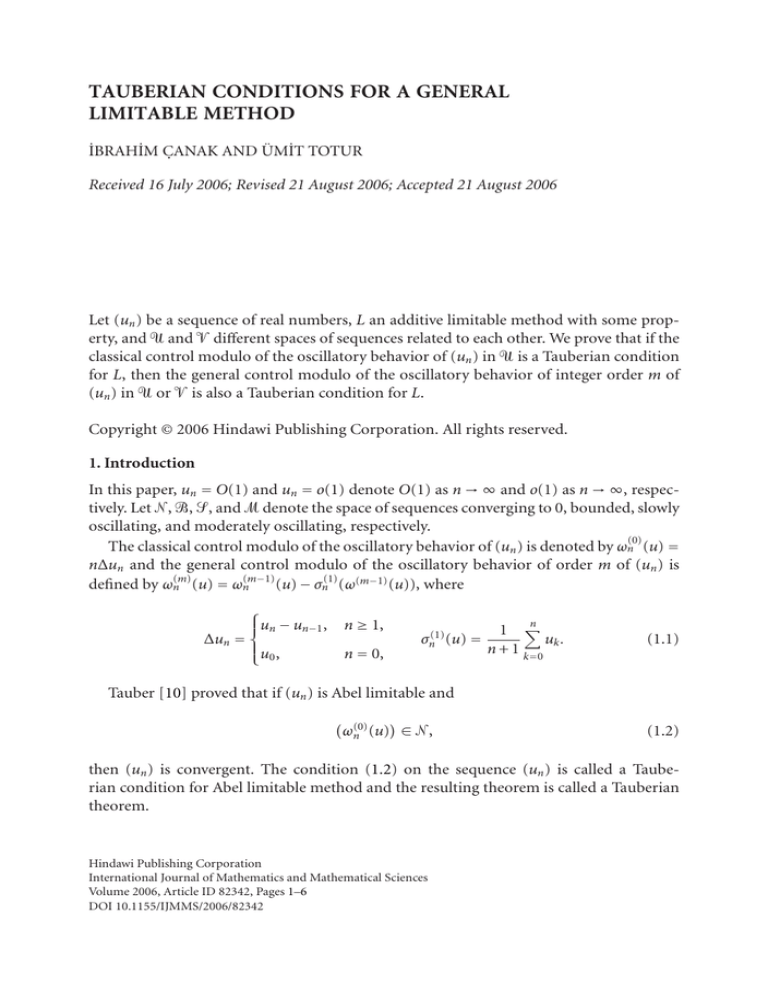
TAUBERIAN CONDITIONS FOR A GENERAL
LIMITABLE METHOD
İBRAHİM C.ANAK AND ÜMİT TOTUR
Received 16 July 2006; Revised 21 August 2006; Accepted 21 August 2006
Let (un ) be a sequence of real numbers, L an additive limitable method with some property, and ᐁ and ᐂ different spaces of sequences related to each other. We prove that if the
classical control modulo of the oscillatory behavior of (un ) in ᐁ is a Tauberian condition
for L, then the general control modulo of the oscillatory behavior of integer order m of
(un ) in ᐁ or ᐂ is also a Tauberian condition for L.
Copyright © 2006 Hindawi Publishing Corporation. All rights reserved.
1. Introduction
In this paper, un = O(1) and un = o(1) denote O(1) as n → ∞ and o(1) as n → ∞, respectively. Let ᏺ, Ꮾ, , and ᏹ denote the space of sequences converging to 0, bounded, slowly
oscillating, and moderately oscillating, respectively.
The classical control modulo of the oscillatory behavior of (un ) is denoted by ωn(0) (u) =
nΔun and the general control modulo of the oscillatory behavior of order m of (un ) is
defined by ωn(m) (u) = ωn(m−1) (u) − σn(1) (ω(m−1) (u)), where
⎧
⎪
⎨un − un−1 ,
n ≥ 1,
Δun = ⎪
⎩u0 ,
σn(1) (u) =
n = 0,
n
1 uk .
n + 1 k =0
(1.1)
Tauber [10] proved that if (un ) is Abel limitable and
ωn(0) (u) ∈ ᏺ,
(1.2)
then (un ) is convergent. The condition (1.2) on the sequence (un ) is called a Tauberian condition for Abel limitable method and the resulting theorem is called a Tauberian
theorem.
Hindawi Publishing Corporation
International Journal of Mathematics and Mathematical Sciences
Volume 2006, Article ID 82342, Pages 1–6
DOI 10.1155/IJMMS/2006/82342
2
Tauberian conditions for a general limitable method
Tauber [10] further proved that the condition
σn(1) ω(0) (u)
∈ᏺ
(1.3)
is also a Tauberian condition. It was shown by Littlewood [6] that the condition (1.2)
could be replaced by
ωn(0) (u) ∈ Ꮾ.
(1.4)
Hardy and Littlewood [5] improved Littlewood’s theorem replacing (1.4) by onesided
boundedness of (ωn(0) (u)).
Stanojević [9] reformulated the definition of slow oscillation given by Schmidt [8] in a
more suitable form and then proved that the conditions (1.2) and (1.3) could be replaced
by
ωn(0) (u) ∈ ,
(1)
σn
ω(0) (u)
∈ ,
(1.5)
(1.6)
respectively.
A generalization of slow oscillation, moderate oscillation, was introduced by Stanojević and it was proved by Dik [4] that (1.5) could be replaced by
ωn(0) (u) ∈ ᏹ,
(1.7)
and (1.6) could not be replaced by
σn(1) ω(0) (u)
∈ ᏹ.
(1.8)
Recently, C.anak and Totur [3] have shown that for any nonnegative integer m ≥ 1,
ωn(m) (u) ∈ ᏹ
(1.9)
is a Tauberian condition for Abel limitable method.
Meyer-König and Tietz [7] proved that if (1.2) is a Tauberian conditions for an additive
and regular limitability method, then (1.3) is a Tauberian condition for L. C.anak et al. [1]
extended and generalized Meyer-König and Tietz’s [7] result and obtained the following
theorems for an additive and (C,1) regular method L.
Theorem 1.1. If (ωn(0) (u)) ∈ is a Tauberian condition for an additive and (C,1) regular
limitable method L, then (ωn(1) (u)) ∈ is a Tauberian condition for L.
Theorem 1.2. If (ωn(0) (u)) ∈ Ꮾ is a Tauberian condition for an additive and (C,1) regular
limitable method L, then (ωn(1) (u)) ∈ Ꮾ is a Tauberian condition for L.
Let ᐁ and ᐂ be distinct spaces of sequences related to each other. In this paper, we
prove that if the classical control modulo of the oscillatory behavior of (un ) in ᐁ is a
Tauberian condition for an additive and (C,1) limitable method L, then the general control modulo of the oscillatory behavior of integer order m of (un ) in ᐁ or ᐂ is also a
Tauberian condition for L.
İ. C.anak and Ü. Totur 3
2. Notations and definitions
Throughout this paper, let u = (un ) be a sequence of real numbers. For each integer m ≥ 0
and for all nonnegative integers n denote σn(m) (u) by
⎧
⎪
⎪
⎨ 1
n
σn(m) (u) = ⎪ n + 1 k=0
⎪
⎩
un ,
σk(m−1) (u) = u0 +
n
Vk(m−1) (Δu)
k
k =1
,
m ≥ 1,
(2.1)
m = 0,
where
⎧
(m−1)
(1)
⎪
⎪
(Δu) ,
⎪
⎨σn V
n
Vn(m) (Δu) = ⎪ 1 ⎪
kΔuk ,
⎪
⎩n+1
m ≥ 1,
m = 0.
(2.2)
k =0
The identity
un − σn(1) (u) = Vn(0) (Δu)
(2.3)
is well known and will be extensively used. We define inductively for each integer m ≥ 1
and for all nonnegative integers n,
(nΔ)m un = nΔ (nΔ)m−1 un ,
where (nΔ)0 un = un .
(2.4)
It is proved in [2] that for each integer m ≥ 1,
ωn(m) (u) = (nΔ)m Vn(m−1) (Δu).
(2.5)
Definition
2.1. A sequence u = (un ) is Abel limitable to s if the limit limx→1− (1 −
∞
x) n=0 un xn = s.
Definition 2.2. A sequence u = (un ) is L limitable to s if L − limn un = s.
A limitation method L is called additive if L − limn un = s and L − limn vn = t imply
that L − limn (un + vn ) = s + t. A limitation method L is called regular if the L − limit of
every convergent sequence is equal to its limit. L is called (C,1) regular if L − limn un = s
implies L − limn σn(1) (u) = s. It is clear that every regular limitable method is (C,1) regular.
Definition 2.3. A sequence u = (un ) is one-sidedly bounded if for some C ≥ 0 and for
each nonnegative integer n, un ≥ −C.
Definition 2.4. A sequence u = (un ) is slowly oscillating [9] if
k
= 0,
Δu
lim+ lim max j
λ→1 n n+1≤k≤[λn] j =n+1
where [λn] denotes the integer part of λn.
(2.6)
4
Tauberian conditions for a general limitable method
A sequence u = (un ) ∈ if and only if (Vn(0) (Δu)) ∈ and (Vn(0) (Δu)) ∈ Ꮾ (see [4]).
The next definition is a generalization of slow oscillation.
Definition 2.5. A sequence u = (un ) is moderately oscillating [9] if for λ > 1,
k
< ∞.
lim max Δu
j
n n+1≤k≤[λn] (2.7)
j =n+1
A sequence (un ) ∈ ᏹ if and only if (Vn(0) (Δu)) ∈ Ꮾ (see [4]).
3. Results and proofs
Theorem 3.1. If (ωn(0) (u)) ∈ ᏹ is a Tauberian condition for L, then for any integer m ≥ 1,
(ωn(m) (u)) ∈ ᏹ is also a Tauberian condition for L.
Proof. Assume that (ωn(0) (u)) ∈ ᏹ is a Tauberian condition for L. Let L − limn un = s.
Since L is (C,1) regular, it follows by (2.3) that L − limn Vn(0) (Δu) = 0. It is obvious that
L − limn un = s implies L − limn (nΔ)m−1 Vn(m−1) (Δu) = 0. Since
ωn(m) (u) = nΔ (nΔ)m−1 Vn(m−1) (Δu)
∈ ᏹ,
(3.1)
by assumption, we have
(nΔ)m−1 Vn(m−1) (Δu) = o(1).
(3.2)
By the same reasoning, we deduce that
(nΔ)m−1 Vn(m−1) (Δu) = nΔ (nΔ)m−2 Vn(m−1) (Δu) = o(1)
(3.3)
and L − limn (nΔ)m−2 Vn(m−1) (Δu) = 0. Again by assumption, we have
(nΔ)m−2 Vn(m−1) (Δu) = o(1).
(3.4)
(nΔ)m−1 Vn(m−1) (Δu) = (nΔ)m−2 Vn(m−2) (Δu) − (nΔ)m−2 Vn(m−1) (Δu),
(3.5)
From the identity
(3.2), and (3.4), we have
(nΔ)m−2 Vn(m−2) (Δu) = o(1).
(3.6)
Continuing in this vein, we have
nΔVn(1) (Δu) = o(1).
(3.7)
Since L − limn Vn(1) (Δu) = 0, it follows by (3.7) that
Vn(1) (Δu) = o(1).
(3.8)
İ. C.anak and Ü. Totur 5
From (3.7) and (3.8), we have Vn(0) (Δu) = o(1). L − limn σn(1) (u) = s and Vn(0) (Δu) =
nΔσn(1) (u) = o(1) imply that limn σn(1) (u) = s. Hence, by (2.3), (un ) converges to s.
Theorem 3.2. If (ωn(0) (u)) ∈ Ꮾ is a Tauberian condition for L, then for any integer m ≥ 1,
(ωn(m) (u)) ∈ Ꮾ is also a Tauberian condition for L.
Proof. Assume that ωn(0) (u) = O(1) is a Tauberian condition for L. Let L − limn un = s.
Since L − limn (nΔ)m−1 Vn(m−1) (Δu) = 0 and ωn(m) (u) = nΔ((nΔ)m−1 Vn(m−1) (Δu)) = O(1),
(nΔ)m−1 Vn(m−1) (Δu) = o(1) by assumption. The rest of the proof is as in the proof of
Theorem 3.1.
Theorem 3.3. If for some C ≥ 0, ωn(0) (u) ≥ −C is a Tauberian condition for L, then for any
integer m ≥ 1, ωn(m) (u) ≥ −C is also a Tauberian condition for L.
Proof. Assume that ωn(0) (u) ≥ −C for some C ≥ 0 is a Tauberian condition for L. Let
L − limn un = s. Since L − limn (nΔ)m−1 Vn(m−1) (Δu) = 0 and ωn(m) (u) = nΔ((nΔ)m−1 Vn(m−1)
(Δu)) ≥ −C, (nΔ)m−1 Vn(m−1) (Δu) = o(1) by assumption. The rest of the proof is as in the
proof of Theorem 3.1.
We now prove that if (ωn(0) (u)) ∈ ᏹ (or ∈ Ꮾ) is a Tauberian condition for L, then for
any integer m ≥ 1, (ωn(m) (u)) ∈ Ꮾ (or ∈ ᏹ) is a Tauberian condition for L, respectively.
Theorem 3.4. If (ωn(0) (u)) ∈ ᏹ is a Tauberian condition for L, then for any integer m ≥ 1,
(ωn(m) (u)) ∈ Ꮾ is also a Tauberian condition for L.
Proof. It is sufficient to note that ωn(m) (u) = (nΔ)m Vn(m−1) (Δu) = Vn(0) (Δω(m−1) (u))
(m−1)
= O(1) implies (ωn
(u)) ∈ ᏹ. Proof now follows from Theorem 3.1.
Theorem 3.5. If (ωn(0) (u)) ∈ Ꮾ is a Tauberian condition for L, then for any integer m ≥ 1,
(ωn(m) (u)) ∈ ᏹ is also a Tauberian condition for L.
Proof. It is sufficient to note that (ωn(m) (u)) ∈ ᏹ implies Vn(0) (Δω(m) (u)) = ωn(m+1) (u) =
O(1). Proof now follows from Theorem 3.4.
Remark 3.6. Because of the inclusion ᏺ ⊂ ⊂ ᏹ, the condition “belonging to ᏹ” can
be replaced by “belonging to ” or “belonging to ᏺ.”
In Theorems 3.1, 3.2, and 3.3, taking m = 1 and replacing ᏹ by , we have [1, Theorems 4.1, 4.2, and 4.4] by C.anak et al.
Acknowledgment
This research was supported by Adnan Menderes University under Grant FEF-06011.
References
[1] İ. C.anak, M. Dik, and F. Dik, On a Theorem of W. Meyer-König and H. Tietz, International
Journal of Mathematics and Mathematical Sciences 2005 (2005), no. 15, 2491–2496.
[2] İ. C.anak and Ü. Totur, A Tauberian theorem with a generalized one-sided condition, preprint,
2005.
6
[3]
[4]
[5]
[6]
[7]
[8]
[9]
[10]
Tauberian conditions for a general limitable method
, Tauberian theorems for Abel limitable sequences with controlled oscillatory behavior,
preprint, 2006.
M. Dik, Tauberian theorems for sequences with moderately oscillatory control modulo, Mathematica Moravica 5 (2001), 57–94.
G. H. Hardy and J. E. Littlewood, Tauberian theorems concerning power series and Dirichlet’s series
whose coeffients are positive, Proceedings of the London Mathematical Society 2 (1914), no. 13,
174–191.
J. E. Littlewood, The converse of Abel’s theorem on power series, Proceedings of the London Mathematical Society 2 (1911), no. 9, 434–448.
W. Meyer-König and H. Tietz, On Tauberian conditions of type o, Bulletin of the American Mathematical Society 73 (1967), 926–927.
R. Schmidt, Über divergente Folgen und lineare Mittelbildungen, Mathematische Zeitschrift 22
(1925), no. 1, 89–152.
Č. V. Stanojević, Analysis of Divergence: Control and Management of Divergent Processes, edited
by İ. C.anak, Graduate Research Seminar Lecture Notes, University of Missouri-Rolla, Missouri,
1998.
A. Tauber, Ein Satz aus der Theorie der unendlichen Reihen, Monatshefte für Mathematik 8
(1897), 273–277.
İbrahım C.anak: Department of Mathematics, Adnan Menderes University, 09010 Aydin, Turkey
E-mail address: icanak@adu.edu.tr
Ümıt Totur: Department of Mathematics, Adnan Menderes University, 09010 Aydin, Turkey
E-mail address: utotur@adu.edu.tr



